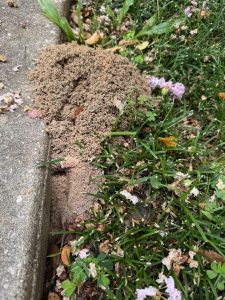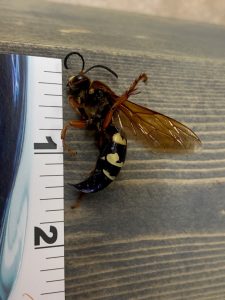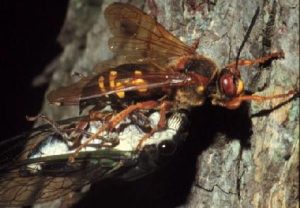
A cicada killer burrow at the Escambia County Extension Office. Photo credit: Carrie Stevenson, UF IFAS Extension
The other day, our Horticulture agent, Beth Bolles, called me over to point out something of interest. Along the sidewalk between our buildings was a sandy burrow that looked like a cross between a fire ant mound and a crawfish burrow. “People ask me about these all the time—you may want to write about them,” she said. Sure enough, just a couple days later I was tagged in a Facebook photo asking if I knew what this weird sandy mound was.

An up-close photo of a cicada killer brought into our office for identification. Photo credit: Beth Bolles, UF IFAS Extension
What Beth pointed out was the burrow of a cicada killer (Sphecius speciosus) wasp, also called the great ground hornet. Cicada killers are large (among the largest in the country, at 1.5-2” long) ground-dwelling wasps that use cicadas for an important part of their life cycle. They can fly, but I have observed them crawling through low weeds and grass. They have black bodies and wings with brilliant yellow stripes on their abdomens, and adults feed on flower nectar.
These wasps’ reproductive cycle is rather fascinating. After males and females emerge from the soil in the summer, they mate while in flight. Females then dig the burrows, using their front legs to scrape soil out of the ground and kick it out with their hind legs. Burrows may be up to 4 feet deep, with branches and larger cells.

A female cicada killer with her cicada prey. Photo credit: North Carolina State University Extension
Future moms then seek out cicadas, which they sting and paralyze on the leg. The wasps drag cicadas on their backs and into their underground burrows. They place 1-4 cicadas in each cell, depending on insect size. Once this task is completed, the females lay eggs—one into each cicada body. The sex of their offspring can be determined by placement, with the more substantial cicadas implanted with future females, who will need the extra energy. Female cicada killers have been observed to share their burrows with as many as 3 other wasps.
While female wasps stay busy with reproduction and burrowing, the males primarily serve roles of protection and competition for mates. Male cicada killers are known to “invade personal space” of humans by hovering at eye level, and can seem aggressive. However, they are harmless—only the females have stingers!
- Wax Myrtle–a Native Evergreen - December 26, 2025
- Yucca–A Tough and Versatile Native Plant - November 26, 2025
- Blazing Star - November 6, 2025
